The first week of July is a busy week. On Wednesday 6 July SCI celebrates its 130th Annual General Meeting. This is your opportunity to quiz the senior officers on the Society's record and to elect representatives to run the Society for the next year. As well as the AGM, the day includes the presentation of awards and medals, an address by the Honorary President, Dr Stephanie Burns, Chairman of Dow Corning, and a keynote address by science writer and broadcaster, Dr Mark Miodownik.
The following day, 7 July, there is an open meeting of the Membership Advisory Committee. Anyone interested in finding out what this committee does and particularly those interested in joining the committee are encouraged to attend.
Finally on Friday 8 July we have our visit to the gardens of Worcester College and the Oxford Botanic Garden. This visit will be preceded by a meeting of your Committee and we are pleased to announce that Chris Moncreiff has agreed to join the Committee. Chris is Technical Director of VHB Herbs, part of the RAR Group which includes Vitacress and Wight Salads.
On 20 July the Professional Horticulture Group South West will be visiting West Kington Nurseries and Whatley Manor Hotel. As usual, members of SCI Horticulture Group are welcome to attend this meeting. The last meeting of the Group visited the University of Bristol Botanic Garden and a report on that visit appears below.
Over the past five years or so the RHS supported by other organisations has convened an annual Green Skills Seminar for the purposes of considering the needs for, and supply of, trained horticulturists. The impetus for these seminars originated with recognition that state education provisions fail to provide adequately for the needs of training technician level horticulturists. Prof Geoff Dixon attended on behalf of SCI Horticulture.
Editor
Bristol Botanic Garden
Unlike many other well-known botanic gardens University of Bristol Botanic Garden has not enjoyed a long history on one site. Originally found in 1882, by the start of this millennium it had already been located on three sites. In 2002 it was decided to move it yet again to a new site closer to the university at The Holmes. The 1.77 hectare garden at the Holmes was relatively undeveloped, but did include a framework of mature ornamental trees to provide a backdrop to the new garden which was started in 2006.
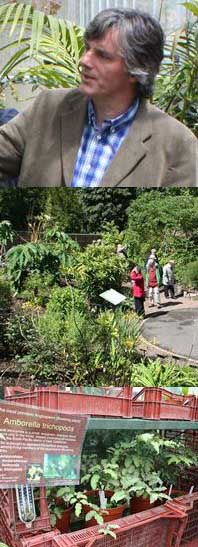
Cheddar Gorge is the home of the Cheddar Pink, Dianthus gratianopolitanus, the county flower of Somerset, and an endangered species although fortunately one that is showing good signs of recovery. The area is also well known as the unique habitat of a number of Sorbus species related to the whitebeam, Sorbus aria. These and other local plants are now being maintained in an area of gardens.
The old garden had built up a collection of plants used in Chinese herbal medicine and it was decided to relocate these to the new site as part of the 'useful plants' collection. The garden has worked closely with Dr Tony Harrison a local herbalist and leader of the Register of Chinese Herbal Medicine to collect the species and group them according to their mode of action. The collection (pictured right) provides not just a reference for those interested in herbal medicine but a valuable resource for those wishing to investigate the active principles within the plants. It also provides a valuable link with China, Chinese money and helps bring fee paying students essential to the university's financial well-being.
The move to the Holmes gave the garden a unique opportunity to reorganise parts of its collection to reflect the new classification of flowering plants established by the Angiosperm Phylogeny Group (APG III). This classification, based on analysis of the cumulative changes in DNA sequences, has shown that the traditional view where the Monocotyledons and Dicotyledons diverged from a common ancestor is invalid. The primitive Magnolids including Magnolias, Laurels and Peppers are more ancient than the monocotyledons. Three further groups are even more primitive; the Nymphales (water lilies), Austrobaileyales and the Amborellales.
The most primitive, the Amborellales, is represented by one remaining species, Amborella trichopoda from the Pacific island of New Caledonia. Although it flourishes on the island, cultivation has proved difficult and Nick Wray was proud to show off the five plants that the Botanic Garden has managed to propagate from the 12 seeds originally collected. The species' primitive vascular system makes them prone to dessication so to emulate the plant's natural environment as a tropical under-shrub the plants are currently grown in the shade of a somewhat Heath Robinson-style pile of plastic trays (pictured right). Unorthodox this may be, but it has enabled them to get both male and female plants to flower, and they now have fruit developing.
See also UK Taxonomy and Systematics Review, published in Horticulture Industry News below
Plant of the Month
Rhus typhina, staghorn sumac, Anacardiaceae
A common sight in 1970's style front gardens, this small tree is more interesting than it might at first appear! 'Rhus' was the Greek name for the species Rhus coriaria and 'typhina' means resembling Typha (bulrushes) - after the persistent inflorescence perhaps.
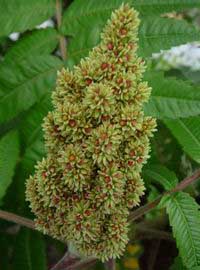
The staghorn or velvet sumac (picture right by Alison Foster) is originally from Eastern North America is high in oils and polyphenols and is an important tannin source. The fruit are used to make a pink lemonade by soaking them in water. All parts of the plant except the roots can be used as a dye, indeed the North American colonists knew the tree as dyer's sumach for the yellow dye they made from it.
In the garden, it will grow in almost any conditions, but will survive on particularly dry and poor soil where other plants fail to thrive. The sumach flowers through the early part of the summer and is a dioecious tree, with male and female flowers on separate plants. On the female trees, the flowers set fruit and these are dense clusters of drupes up to 20 cm long. The leaves make for a stunning autumn display as they turn a vibrant red colour. Long after the leaves have been shed the fruits remain right through the winter and can still be seen on the tree when the next season's flowers are present.
There is however, a word of caution. This tree will colonise a large area if left unchecked. It spreads by both seed and rhizomes but with a little careful tending makes a useful addition to many gardens.
Alison Foster
Oxford Botanic Garden
Medicinal Plant of the Month
Galega officinalis, goat's rue, Fabaceae
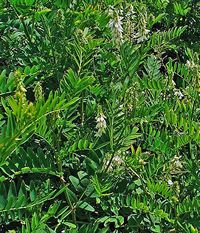
Galega officinalis (picture right by H. Zell) has long been used as a treatment for diabetes. It has been found to contain galegine and guanidine, nitrogen containing molecules that have anti-diabetic activity. Modelled on these compounds is metformin - a bis-guanidine structure that is used to sensitize cells to insulin so that smaller quantities of insulin can be taken. A 20 year landmark study - the UK Prospective Diabetes Study (UKPDS) run by two Oxford academic clinicians has shown that metformin significantly improves the outcome of patients with Type II diabetes. Those taking metformin have a longer life expectancy, due to lower levels of side-effects such as vision loss, foot and such leg problems as skin ulcers, infection, necrosis and even gangrene associated with Type II diabetes.
And if all this wasn't enough, the stem pulp can be used to make paper!

Alison Foster
Oxford Botanic Garden
News from our Associates
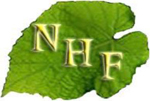
The NHF is in the process of preparing a paper on 'A New Vision for Horticulture R&D'. Anyone who feels they may have views should contact our representative, Geoff Dixon.
Horticulture Industry News
For the very latest horticultural news follow us on Facebook and or
Twitter.
UK Taxonomy and Systematics Review published
In response to the House of Lords Science and Technology Committee report, highlighting concerns over the state of taxonomy and systematics in the UK, the Natural Environment Research Council commissioned a study on behalf of all research funders in this area. The study comprised two parts: 1) The UK Taxonomy and Systematics Review, which provides quantitative data on the current state of the subject in the UK, as requested by the Science and Technology Committee: 2) A document, Developing a National Strategy in Taxonomy and Systematics, exploring the need for a national strategy in this area and how it might be developed. A full response to the study will be published online by the end of July 2011.
Science as a public enterprise
The Royal Society is undertaking a new, major policy study on the use of scientific information as it affects scientists and society. It will ask how scientific information should be managed to support innovative and productive research that reflects public values. They welcome submissions as soon as possible, and before the 5 August 2011.
Plants clean air of formaldehyde
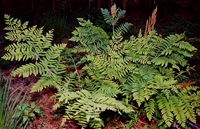
Ferns had the highest formaldehyde removal efficiency of the five classes of plants tested, with Japanese Royal Fern, Osmunda japonica (similar to Osmunda regalis pictured right by Christian Fischer), determined to be most effective of all 86 species, coming in at 50 times more effective than the least efficient species, Dracaena deremensis. More
Foreigners are not all bad...
Conservationists and land managers should no longer use the origins of plant species as a guiding principle for policy and management decisions, argues a team of ecologists led by Marc Davis. Instead, they should focus on the function of plant species and whether they benefit or threaten biodiversity, human health, ecological services and economies. The idea of plant 'nativeness' was introduced in the mid-19th century, leading to the discipline of 'invasion biology' in the 1990s. But there is little evidence to support the claim that non-native species are the 'enemies of man and nature', say the authors. In fact, recent research suggests that alien species can be beneficial as they tend to increase the number of species in most environments, for example. More and More
... and the natives can be unfriendly
'Thugs' are plant species that bully others, take over the landscape and destroy ecosystems. While it's perhaps unexpected to hear of plants acting this way, what is really surprising is that these so-called thugs are home-grown. We usually assume that species wrecking havoc this way are exotic aliens; invasive 'outsider' species that have colonised our land and which now hold dominion over our somehow more natural, vulnerable wildlife. A new research study published by scientists in the Kew Bulletin fingers three native species of particular concern: brambles, bracken and ivy. These three species, according to the study, may do more damage to British woodlands than either rhododendron or sycamore, which are both invasives. Professor Rob Marrs of the University of Liverpool and colleagues have quantified their impact for the first time. They used mathematical analysis to work out which environmental factors, such as climate, soil, or land management, were important in controlling the composition of these species and showed that, on a nationwide scale, thugs such as bramble, bracken and ivy appear to influence what vegetation grows in our woods more than rhododendron or sycamore. They actually cause four times the variation in natural flora compared to the aliens. More
GM Aphid resistant wheat for trialling?
Rothamsted Research have submitted an application to the Advisory Committee on Releases to the Environment (ACRE) for permission to carry out a GM field trial in 2012 and 2013. The purpose of this trial is to test whether GM wheat plants capable of making an aphid pheromone alarm are better able to resist aphids under field conditions. They expect to hear from ACRE in 3 to 6 months time. The aphid resistance gene has been synthesized but is similar to a gene found in peppermint (Mentha x piperita) and hops (Humulus) and over 300 varieties of plants. It enables the plant to produce the sesquiterpine, (E)-beta-farnesene (EBF), the chemical aphids produce to warn others to keep away. More and More
Heavy snow alters ecological balance
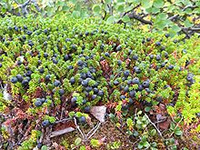
Faster DNA analysis
An international team of researchers has developed a new DNA technology which makes it possible to perform reliable analyses on DNA quantities that are a thousand times smaller than was previously the case. The method can be used, for example, to study small quantities of stem cells, starting tumour tissue, parts of plant and animal tissue, and archaeological samples. The new method is published in Nature Methods under the name LinDA. The main difference between LinDA and commonly used methods is how DNA molecules are copied to make them identifiable in analysis equipment. With existing PCR based methods, DNA fragments are amplified exponentially while LinDA DNA is amplified linearly. The latter is in particular attractive for the identification and quantification of low abundant DNA (or RNA) fragments. More
Resistant plant pumps glyphosate into cell vacuole
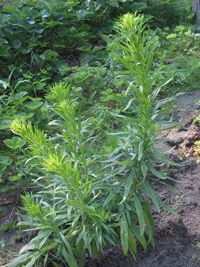
Growing point decides which way to bend...
The process of phototropism by which plants grow towards light, is well-documented in grasses, but has been difficult to resolve in 'dicotyledons' (see Bristol Botanic Garden above). Research in the model plant Arabidopsis thaliana now shows that the hormones that cause phototropism are distributed from the tip of the plant rather than where the plant's stem bends as had been thought. The bending is known to be controlled by the plant hormone auxin. For the past decade, it had been thought that auxin was transported down the stem of dicot plants and then moved laterally to epidermal areas to cause bending. A team from the Universities of Glasgow and Purdue, have found that the auxin instead is redistributed laterally at the plant tip and then moves down to the bending point, as is the case in grasses. More
...while enzyme control their stretch
Researchers have found that an enzyme called protein phosphatase 2A, or PP2A, regulates ethylene production. PP2A is a relatively common enzyme that removes phosphoryl groups from proteins to control which proteins are active in the cell. PP2A also removes phosphoryl groups from different versions, or isozymes, of the plant protein acetyl-CoA synthetase (ACS), a key enzyme involved in regulating ethylene production. They found that dephosphorylation of several isozymes of ACS was necessary to reduce the production of ethylene in embryonic plants, but dephosphorylation of at least one isozyme positively regulated ethylene production. When embryonic plants produced less ethylene, their cells elongated, a necessary process for the plants to break through the soil and reach sunlight.
Testing the air to avoid pesticide overuse
A testing kit has been developed so that growers can detect airborne diseases before they infect crops. Produced by the National Pollen and Aerobiology Research Unit (NPARU) based at the University of Worcester. Professor Roy Kennedy, director of the NPARU, said 'It means farmers no longer have to waste time and money spraying crops when there is no disease in the air'. Growers can check online when the crop is at risk from infection and on days when there is a high reading they can use the testing kit in their fields to determine whether disease is in the air. Fred Tyler, a spokesman for a co-operative of small growers, said: 'The kits show great promise in reducing the amount of pesticides required to control disease in crops.' More
Quotes of the Month
'Ignorance more frequently begets confidence than does knowledge'.
Charles Darwin
Events Calendar
Other Events of Interest
Medicinal, Aromatic and Nutraceutical Plants from Mountainous Areas
6 - 9 July, International Society for Horticultural Science
Saas-Fee, Switzerland
Bee ecology and pollination in the agricultural landscape
7 July, Society of Biology
Hatfield UK
Ohio Short Course
9 - 12 July, Ohio Florist Association
Columbus, USA
The co-evolution of bees and flowers
11 July, Society of Biology
Farnborough, Kent, UK
The Woking Show
13 July, The Woking Nurseries
Worplesdon, UK
Quality Management of Fresh Cut Produce: Convenience Food for a Tasteful Life
17 - 21 July, International Society for Horticultural Science
Turin, Italy
Fruit Focus
20 July, Haymarket Media Group
East Malling, UK
Eastgro Horticultural Trade Show
3 Aug
Diss, UK
Medicinal and Aromatic Plants
16 - 19 Aug, International Society for Horticultural Science
Petén, Guatemala
Keeping Pesticides out of Water Workshop
17 - 18 Aug, Association of Applied Biologists
Wageningen, The Netherlands
Plantarium
24 - 27 Aug,
Boskoop, The Netherlands
Four Oaks Trade Show
4 - 6 Sep
Lower Withington, UK
Spoga Gafa Trade Fair
4 - 6 Sep, Koelnmesse
Cologne, UK
Saltex
6 - 8 Sep, Institute of Groundsmanship
Windsor, UK
Mycotoxins in Nuts and Dried Fruits
10 - 12 Sep, International Society for Horticultural Science
Damghan, Iran
Fruit Breeding and Genetics
11 - 15 Sep, International Society for Horticultural Science
Warsaw, Poland
Genetically Modified Organisms in Horticulture Symposium
11 - 15 Sep, Eucarpia
Mpumalanga, South Africa
European Whitefly Symposium
11 - 16 Sep, The Hebrew University of Jerusalem, Tel Aviv University and Volcani Center
Rehovot, Israel
Flormart
15 - 17 Sep, PadovaFiere
Padova, Italy
Naivasha Horticultural Fair
16 - 17 Sep, see also Commercial Horticultural Association
Naivasha, Kenya
Integrated Control in Protected Crops, Temperate Climate
18 - 22 Sep, Association of Applied Biologists
Sutton Scotney, UK
In Vitro Culture and Horticultural Breeding
18 - 22 Sep, International Society for Horticultural Science
Ghent, Belgium
Exocytosis in animals, fungi and plants
19 - 21 Sep, Society of Experimental Biology
London, UK
Biomass and Energy Crops
21 - 23 Sep, Association of Applied Biologists
Champaign, USA
IPM Dubai
26 - 26 Sep, Messe Essen
Dubai, UAE
If you would like to advertise a forthcoming event please contact. zoe.daniel@soci.org
Horticulture Group Contact Details
For submitting ideas or to volunteer to be part of a committee or a group, please contact:
Chairman - Peter Grimbly
Meetings Secretary - Marion Stainton
Minutes Secretary - Margaret Waddy
Newsletter Co-ordinator - Sue Grimbly, E: scihortigroup@btinternet.com
Group Coordinator - Zoe Daniel zoe.daniel@soci.org T: +44 (0)20 7598 1594
